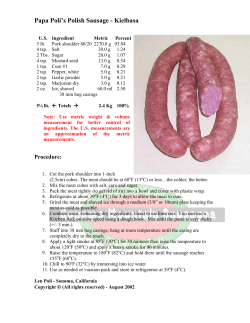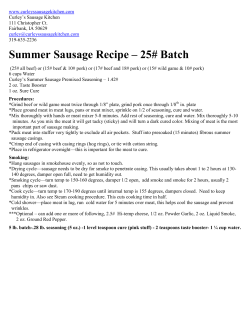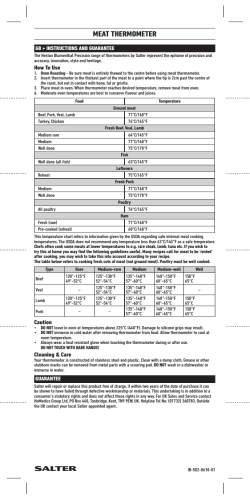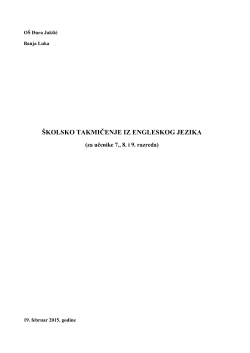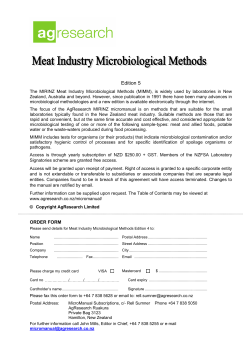
Meat, Poultry and Fish Technology
Textbook on Meat, Poultry and Fish Technology ABOUT THE BOOK The book entitled "Textbook on Meat, Poultry and Fish Technology" contains Part I Fresh Meat technology Chapter 1-11 containing History and development; Structure and chemistry of animal tissues; Postmortem changes- rigor mortis; Effect of transport on meat quality; PSE and DFD in meat quality; Composition, essential nutrients in meat and poultry meat; General quality characterization; Meat microbiology; Factors affecting; Tenderization; and Chemical residues. Part II Poultry and Fish Technology Chapter 12-30 contains History and development; Anti-nutrients and antibiotics effect on egg and meat; Quality identification and quality maintenance of poultry meat; Structure, chemical, nutritional and microbiological quality of poultry meat; Nutritive value, preservation and packaging techniques; Quality identification and factors influencing the quality; Pre-slaughter care, transportation, resting, fasting, ante-mortem examination; Methods of slaughter and slaughtering procedurepostmortem inspection; Yield and loss in poultry carcass component parts; Structure, nutritive value, compositional chemistry, microbiology and functional properties of eggs; Low cholesterol-cum-designer eggs; GMP, HACCP, Codex regulation for food products safety, WTO/GOI regulations; National and international regulations, Utilization of fish processing waste; Fishery resources, fishes, transportation, processing, preservation, grading standards; Post-processing value added meat for export-integration, poultry and fish processing and marketing; Storage, packaging, preservation methods; Cooking and preparation of further processed poultry and fish products. This is a dependable text book not only for the students of all Veterinary Colleges of India, but also it serves as a helpful guide to the teaching faculty who are engaged in teaching in the area of Livestock Products Technology/Animal Products Technology/ Meat Science and Technology/Food Science and Technology. ABOUT THE AUTHORS Dr. Jhari Sahoo, obtained his M.V. Sc. (APT) from HAU, Hisar and Ph.D. (LPT) from IVRI, Izatnagar. He has about 32 years of experience as teaching faculty. He served for a long period of 21years at Department of Animal Products technology, CCSHAU, Hisar in the capacity of Assistant professor, Associate professor and Professor. Later on he joined to the post of professor on dt.22.12.2003 at PAU, Ludhiana and remained Professor-cum-Head from dt.06.01.2004 to dt.12.08.2012 in the Department of Livestock Products Technology at PAU/GADVASU. Dr. Manish Kumar Chatli, has more than 16 year experience in industry, teaching, research and extension in the area of Livestock Products Technology. He worked as Dairy Manager, Bombay and Assistant Professor at CSK HPKV, Palampur. He has joined PAU as Associate Professor in 2003 and subsequently promoted to Professor in 2009 and Head position in 2012. Textbook on Meat, Poultry and Fish Technology Jhari Sahoo Manish Kumar Chatli Department of Livestock Products Technology College of Veterinary Science Guru Angad Dev Veterinary and Animal Sciences University Ludhiana – 141004 (Punjab) 2015 Daya Publishing House® A Division of Astral International Pvt. Ltd. New Delhi – 110 002 © 2015 AUTHORS ISBN 978-93-5124-344-1 (Hardbound) ISBN 978-93-5130-299-5 (International Edition) Publisher’s note: Every possible effort has been made to ensure that the information contained in this book is accurate at the time of going to press, and the publisher and author cannot accept responsibility for any errors or omissions, however caused. No responsibility for loss or damage occasioned to any person acting, or refraining from action, as a result of the material in this publication can be accepted by the editor, the publisher or the author. The Publisher is not associated with any product or vendor mentioned in the book. The contents of this work are intended to further general scientific research, understanding and discussion only. Readers should consult with a specialist where appropriate. Every effort has been made to trace the owners of copyright material used in this book, if any. The author and the publisher will be grateful for any omission brought to their notice for acknowledgement in the future editions of the book. All Rights reserved under International Copyright Conventions. No part of this publication may be reproduced, stored in a retrieval system, or transmitted in any form or by any means, electronic, mechanical, photocopying, recording or otherwise without the prior written consent of the publisher and the copyright owner. Published by : Daya Publishing House® A Division of Astral International Pvt. Ltd. – ISO 9001:2008 Certified Company – House No. 96, Gali No. 6, Block-C, 30ft Road, Tomar Colony, Burari New Delhi-110 084 E-mail: [email protected] Website: www.astralint.com Sales Office : 4760-61/23, Ansari Road, Darya Ganj New Delhi-110 002 Ph. 011-23245578, 23244987 Laser Typesetting : Classic Computer Services Delhi - 110 035 Printed at : Thomson Press India Limited PRINTED IN INDIA Preface The Expert Committee of the Indian Council of Medical Research (ICMR) has recommended 60 g of protein per day with net protein utilization (NPU) of 65. A minimum requirement of animal protein would be targeted at 20 g per person per day compared to the present availability of 10.8 g and the world average of 25 g. Demand for meat and poultry products is also expected to grow in tune with the population growth, rising incomes and increasing urbanization. In view of this, supplying wholesome, safe and acceptable meat foods to the ever increasing non-vegetarian consumers must be ensured. There are 30 export-oriented modern abattoirs and 77 meat processing plants registered with APEDA exporting raw meat (chilled and frozen) to about 56 countries. The present production of meat is estimated at 6.27 million tons in 2010 (FAO, 2012), which is 2.21 per cent of the world’s meat production. The contribution of meat from buffalo is about 23.33 per cent, while cattle contributes about 17.34 per cent, sheep 4.61 per cent, goat 9.36 per cent, pig 5.31 per cent, poultry 36.68 per cent and other species 3.37 per cent. The meat production has increased from 764,000 tonnes in 1970-71 to 6.27 million tons in 2010. The compounded average growth rate (CAGR) during the last two decades works out to be 4.5 per cent. It is noticed that about 10.6 per cent cattle, 10.6 per cent buffaloes, 24.1 per cent sheep, 58.7 per cent goats, 95.0 per cent pigs and 190.0 per cent chicken are slaughtered each year. The value of meat and by-products is Rs 79,889 crore including skin and hides, while the export value of meat and meat products work outs to be more than Rs 6,000 crore in the year 2009-10. The contribution of buffalo meat accounts for more than 75 per cent of total exports/ foreign earnings. The poultry has gaining the widely acceptance by consumers and growing 10-15 per cent annually. The chicken meat contributes about 37 per cent vi meat to total production and number one contributors. The growth is expected more in near future. This might be due to popularity, price, easy availability, no religious taboos and much more characteristics in poultry. There is a changing trend in consumer priorities. Today, the consumer looks out for the Safety of the products, Animal Welfare, Ethics of the trade, Reliability and Zero Risk. With a view to this, The Food Safety and Standards Authority of India (FSSAI) has been established under Food Safety and Standards Act, 2006 which consolidates various acts and orders that have hitherto handled food related issues in various Ministries and Departments. FSSAI has been created for laying down science based standards for articles of food and to regulate their manufacture, storage, distribution, sale and import to ensure availability of safe and wholesome food for human consumption. The conditions of domestic meat market in India is very precarious with acute problems of environmental pollution, animal welfare issues, lack of ante mortem and postmortem meat inspection, unhygienic slaughter practices, unhygienic transport of dressed carcasses from slaughter houses to the retail shops and very unhygienic substandard retail meat shops. It is the need of the hour to awake and aware the all concerned persons including students and faculty to improve the aforementioned prevalent situations of the country. Prevention of postharvest loss of meat in terms of both quantity and quality is indirectly increasing of meat production. This is possible only if the persons involved directly/ or indirectly should have knowledge about the meat production, processing, preservation, packaging and marketing safely of meat and poultry products till it reaches the consumer table. The students and teachers are at foundation level for this. Keeping in view the above matter, very sincere efforts were made by the authors to publish this book “Textbook on Meat, Poultry and Fish Technology”. The first author of the book Dr. Jhari Sahoo has been associated with industry, teaching, research, training and quality control in the field of meat and poultry products technology for more than 32 years, who has been aware of their problems and needs. He also helped Secretary, Veterinary Council of India while developing course curriculum both in the old and new VCI Syllabus pertaining to the subject discipline of Livestock Products Technology. This book has incorporated the Veterinary Council of India(VCI) New Syllabus 2008 Course No. LPT-321 Course Title: Meat Science prescribed for B.V. Sc. and A.H. degree programme and BSMA (ICAR) syllabus for Course No. LPT 601 Course Title: Fresh meat technology and LPT 603 title: Poultry and fish products technology. This book can be used as a dependable primary textbook for B.V. Sc. and A.H., M.V.Sc. and Ph.D. students of different veterinary colleges of the country. Besides, this book is of immense help to the teaching faculty of State Agricultural Universities(SAUs) and Veterinary Universities of the country who are engaged in teaching in the area of Livestock Products Technology/Animal Products Technology/Meat Science and Technology/Food Science and Technology. vii I am thankful to the co-author Dr. Manish Kumar Chatli for his contribution in some chapters of the book. I am dedicating this book to my darling wife Pravasini, for her constant support, cooperation and encouragement in every step while writing the book. Dr. J. Sahoo Department of Livestock Products Technology, College of Veterinary Science, Guru Angad Dev Veterinary and Animal Sciences University, Ludhiana – 141004 (Punjab), India Phone: +91-161-2414025 Fax: +91-161-2400822 Mobile: +91-9417463926 E-mail: [email protected], sahoo_ [email protected]; [email protected] Contents Preface v Part I–Fresh Meat Technology 1. History and Development of Meat Science and Meat Industry, Current Trends and Prospects of Meat Industry 2. Structure and Chemistry of Animal Tissues 43 3. Muscle Functions and Postmortem Changes: Rigor Mortis, Conversion of Muscle to Meat 85 4. Effect of Transport on Meat Quality: Its Veterinary and Clinical Importance 103 5. PSE and DFD in Meat Quality 113 6. Composition, Essential Nutrients in Meat and Poultry Meat 129 7. General Quality Characterization and Evaluation of Meat and Meat Products 151 8. Meat Microbiology 195 9. Factors Affecting Quality of Meat 205 3 10. Tenderization of Meat 261 11. Chemical Residues in Meat and their Effects on the Health of the Consumer 287 x Part II–Poultry and Fish Technology 12. History and Development of Poultry Meat and Egg Processing Industry 321 13. Commonly Occurring Anti-Nutrients, and Antibiotics in Poultry Feed Ingredients and its Effect on Egg and Meat Nutrition 337 14. Quality Identification and Quality Maintenance of Poultry Meat 347 15. Structure, Chemical, Nutritional and Microbiological Quality of Poultry Meat 361 16. Nutritive Value, Preservation and Packaging Techniques of Shelled and Liquid Eggs 387 17. Quality Identification of Shell Eggs and Factors Influencing the Quality 417 18. Pre-slaughter Care, Transportation, Resting, Fasting, Ante-mortem Examination 425 19. Methods of Slaughter and Slaughtering Procedure-Postmortem Inspection, Reasons for Condemnation of Carcass 437 20. Yield And Loss in Poultry Carcass Component Parts, Deboned Meat Quality and Grading of Dressed Chicken 471 21. Structure, Nutritive Value, Compositional Chemistry, Microbiology and Functional Properties of Eggs 487 22. Low Cholesterol-cum-Designer Eggs 531 23. GMP, HACCP Procedures for Food Safety, Codex Regulation for Food Products Safety, WTO/GOI Regulations for Import and Export of Poultry Products 541 24. National and International Rgulations, Standards, Quality Control and Marketing of Fish and Fish Products 575 25. Utilization of Fish Processing Waste 595 26. Fishery Resources, Marine and Freshwater Fishes, Transportation, Processing, Preservation, Grading Standards 607 27. Post-processing Value Added Meat for Export-Integration, Poultry and Fish Processing and Marketing 647 xi 28. Storage and Packaging of Poultry and Fish Products 657 29. Preservation Methods of Poultry Meat and Fish Products 713 30. Cooking Methods and Preparation of Further Processed Poultry and Fish Products 777 Index 825
© Copyright 2025



